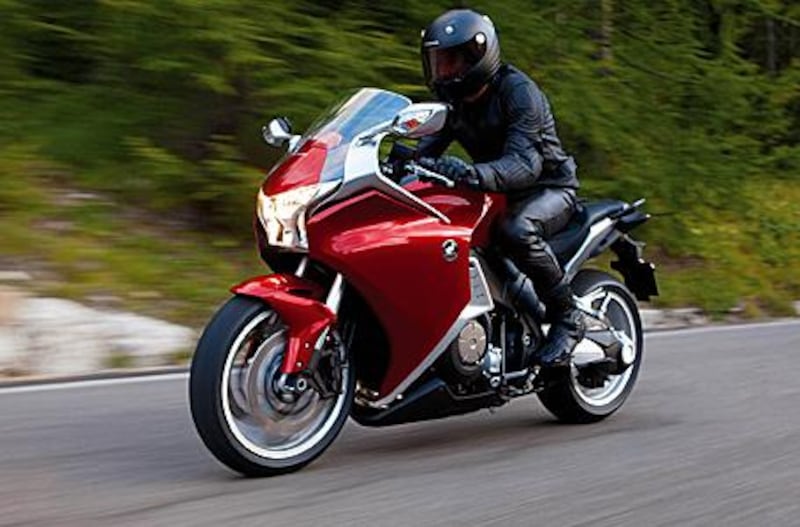KINGSTON, ONTARIO // I have to give you a warning prior to you reading the rest of this review: this is not a complete road test. Although I did ride Honda's all-new (and semi-revolutionary) VFR1200, my evaluation was but a short one, a mere hour-and-a-half aboard a motorcycle many within Honda Motor Company hope, expect and pray will change the average biker's impression of the world's largest motorcycle manufacturer.
What is becoming obvious is that Honda is trying to distance itself from the madding crowd - i.e. the rest of the Japanese marques it traditionally competes with. It's fair to say that while Honda will never abandon its grass-roots market that saw it sell more than 15 million two-wheelers last year, it's also true that, in developed countries, it eyes BMW's and Harley-Davidson's market with growing envy. While HD has floundered somewhat in this Great Recession, BMW still manages to charge a premium for its products, a surcharge Honda finds galling since the Japanese giant firmly believes its machines are superior to the German's.
While oddball projects like the Rune revealed Honda's desire to play in this rarefied segment, it's only with the introduction of the VFR1200 that it has so blatantly expressed its desires to move its brand upmarket. Make no mistake, the new, expanded and shaft-driven VFR is aimed directly at the K1300S, BMW's flagship sportbike, sometimes sports-tourer. Of course, as these are early days, we have no idea of the pricing of the new Honda, and while the reality of how well the new VFR performs is important, we still need to reserve final judgement because motorcycle consumers may not be ready for a Honda that is more expensive than the BMW equivalent.
What is without question, however, is that the new VFR1200 is a more than worthy competitor to the big Beemer, though in some surprising cases, not all that similar. Take the engine, for instance. The Honda has a 1,237cc V4 (with an unusual 76° between the banks of cylinders) while the BMW has a 1,293cc inline four. In the end, despite the technical differences and the small discrepancy in claimed horsepower (172 for the Honda versus 175 for the BMW), they are remarkably similar in performance. The smaller Honda actually has a slight advantage at low speed, torquing impressively through the gears, while the big BMW sprints a little harder as the revs near redline. But the differences are negligible.
How the motors feel, however, is completely different and in surprising ways. The BMW, for instance, sounds a little thrashy - much like a modern Triumph - yet is remarkably smooth. The VFR, on the other hand, sounds like a sophisticated turbine but does quake a little more than the BMW, though the vibrations would be even worse were it not for the VFR's unique (for a vee-four) offset crankpins. Honda will be making much of its new six-speed gearbox, which is the same type of automatic-shifting, dual-clutch manuals that are taking the car industry by storm. The BMW's optional Gear Shift Assistant shifting system is not as hi-tech but almost as effective. For any gear above first, you simply pull or push on the foot lever and the BMW cuts the ignition, operates the clutch and shifts the gears all by itself. It's smooth enough that Honda's technological advantage is somewhat muted.
Ergonomically, the new VFR1200 is very reminiscent of the 800 it supersedes. The handlebar angle and rise is almost identical and there's a similar distance from the seat to the footpegs. The K1300S has a much more aggressive, sporty riding position with a lower handlebar and higher footpegs. The windscreen also rides lower, though surprisingly, the difference in wind protection is not as great as you would think.
The equipment level of both bikes are also remarkably similar. Both are shaft-driven (BMW with its torque-effect-reducing Paralever system; the VFR with a unique offset pivot system that Honda claims does the same thing), both are fuel injected have anti-lock brakes. Saddlebags are available for both too. If Honda is looking for an attribute to elevate the VFR to BMW's perceived place in motorcycling's pecking order, it is in the fit and finish department. The VFR is simply the best-built motorcycle I have ever seen.
Panel gaps are car-industry even, there are no exposed bolts or clamps and the materials used throughout the bike render the VFR the Audi-equivalent (by far the car-industry standard-bearer in this regard) of the motorcycle world. So, from a pure performance perspective, the VFR1200 is a certifiable player in the upper-level sport touring segment, equal in execution to anything from Europe. Only time will tell whether consumers believe brand Honda is equal to the task of prying (normally very loyal) buyers away from BMW. motoring@thenational.ae






